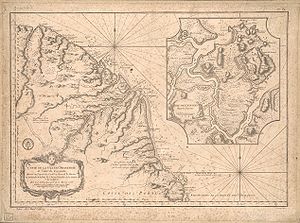
Back غزو كايين (1809) Arabic Aloubadeg Gwiana c'hall Breton Invasión de la Guayana Francesa Spanish Occupation de la Guyane par l'armée luso-brésilienne French Взятие Кайенны (1809) Russian
This article has multiple issues. Please help improve it or discuss these issues on the talk page. (Learn how and when to remove these template messages)
|
| Invasion of Cayenne | |||||||
|---|---|---|---|---|---|---|---|
| Part of the Napoleonic Wars | |||||||
 Carte de la Guyane françoise et l'isle de Cayenne, Jacques-Nicolas Bellin | |||||||
| |||||||
| Belligerents | |||||||
|
|
| ||||||
| Commanders and leaders | |||||||
|
|
| ||||||
| Strength | |||||||
|
3,250 1 frigate 2 brigs 1 schooner 2 cutters | 1,250 | ||||||
| Casualties and losses | |||||||
| 33 killed and wounded |
36 killed and wounded 400 captured | ||||||
The Portuguese conquest of French Guiana, also known as Conquest of Cayenne (Portuguese: Conquista de Caiena), was a military operation against Cayenne, capital of the South American colony of French Guiana, launched in January 1809 in the context of the Napoleonic Wars. The invasion was undertaken by a combined expeditionary force that included Portuguese (from Portugal and from Colonial Brazil) and British military contingents.
The invasion was part of a series of attacks on French-held territory in the Americas during 1809, and due to commitments elsewhere, the British Royal Navy was unable to send substantial forces to attack the fortified river port. Instead, appeals were made to the Portuguese government, which had fled Portugal the year before during the Peninsular War and was resident in Brazil, its largest colony. In exchange for providing troops and transports for the operation, the Portuguese were promised Guiana as an expansion of their holdings in Brazil for the duration of the conflict.
The British contribution was small, consisting solely of the minor warship HMS Confiance. Confiance however had a highly effective crew and an experienced captain in James Lucas Yeo, who was to command the entire expedition. The more substantial Portuguese contingent consisted of 700 regular soldiers of the colonial Army of Brazil, led by Lieutenant-colonel Manuel Marques de Elva Portugal, 550 marines of the Royal Brigade of the Navy detached in Brazil and several warships to act as transports and provide offshore artillery support.[2] The French defenders were weakened by years of Royal Navy blockade and could only muster 400 regular infantry and 800 unreliable militia, formed in part from the territory's free black population. As a result, resistance was inconsistent and despite Cayenne's strong fortifications, the territory fell within a week.
It is considered to be the baptism of fire of the Brazilian Marine Corps, as there was a participation of the Royal Brigade of the Navy that would give origin to it.[3]
© MMXXIII Rich X Search. We shall prevail. All rights reserved. Rich X Search